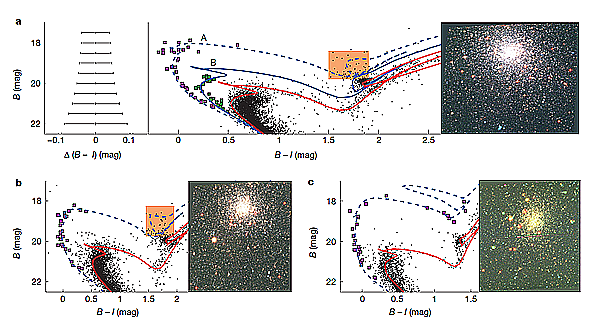
By with LI Chengyuan
Caption: the multi-color image of NGC1783 obtained by observations of Hubble Space Telescope. The distance between NGC1783 and earth is 160 thousands light-years. NGC1783 contains stars with total mass of 170 thousands solar mass. A new study by astronomers from Purple Mountain Observatory, the Kavli Institute for Astronomy and Astrophysics at Peking University, the National Astronomical Observatories of the Chinese Academy of Sciences, Northwestern University, and the Adler Planetarium has revealed that the new stellar populations in NGC1783 were originated from accreted gas of its outskirt environment.
Star clusters are the most striking objects in the universe, which usually contain thousands of stars. A traditional view on star clusters is they contain coeval stellar populations, that means, all stars in a star cluster have the same age. Subsequently, the discovery of multiple stellar populations in oldest Galactic globular clusters has dramatically changed astronomers’ understanding of stellar populations in star clusters. How to form secondary newborn stars in a star cluster hence become an open question. A study that lead by Dr. Chengyuan Li, an project researcher of Purple Mountain Observatory (PMO), has made a breakthrough on this topic, a research team that is composed of astronomers from Purple Mountain Observatory, the Kavli Institute for Astronomy and Astrophysics at Peking University (KIAA), the National Astronomical Observatory of the Chinese Academy of Sciences (NAOC), Northwestern University, and the Adler Planetarium, reported an exciting discovery of several new stellar populations in three young globular clusters, concluding that those newborn stars were actually comes from the external gas by gravity accretions. This work has been published in Nature in 28th, Jan. 2016 (http://dx.doi.org/10.1038/nature16493).
“The first stellar population usually contains several most massive stars, those stars will contribute lots of energetic photons into space, heating the initial gas up. ”, Dr. Chengyuan Li, the project researcher of Purple Mountain Observatory, said: “the hot initial will quickly escape from its host star cluster, hence quenching the star formation. That’s why people expect that stars in star clusters are coeval, because they all formed in a very short period.”
“Stars in those star clusters, are more like the adapted babies rather than the ‘biological’ generations”, explained by Prof. Richard de Grijs at Kavli Institute for Astronomy ande Astrophysics, one of the main authors in this work.
Because the Galactic globular clusters are too old, which prevent people from investigating their early information. In order to get more young star clusters, this research focused on three extragalactic young clusters that belong to Large Magellanic Cloud and Small Magellanic Cloud. By analyzing the colors and luminosities of stars in these three clusters, they found they all contains young stellar populations. Take the star cluster NGC1783 as an example, most of its member stars harbor the ages of around 1.4 billion year, and there are two younger stellar populations, whose ages are 450 million years and 890 million years, respectively.
“Because the stellar winds of first stellar populations will quickly exhausted the initial gas of a star cluster, people believe after at maximum 10 million years, star cluster will stop their star forming process.” Explained by prof. Licai Deng, a senior researcher of National Astronomical Observatory of Chinese Academy of Sciences.

By with LI Chengyuan
Observational data reveals the characteristics of variously aged stars observed in the globular cluster NGC 1783. Black points represents stars with the age of 1.4 billion years, while green squares represent the 890 million year old stars, and the purple squares alone with the black points represented in the orange square to the right represent 450 million year old stars. The apparent three stellar sequences in the color-luminosity diagram clearly indicate three substantial populations of stars with different ages. (Credit: Chengyuan Li and Richard de Grijs, KIAA)
By analyzing the dynamics of the young stellar populations, the research team conclude that those young stars should have an external origin rather than an internal origin. Numerical calculation has showed that those stars can accrete gas when they orbit to their host galaxies, then make new stars when they accumulate enough gas. This scenario can date to 1952, after more than half a century ago, this team has, the first time, found the direct observational evidence that support to this scenario. “We found except for these three cluster, other clusters in Large and Small Magellanic Cloud seems harbor the similar feature, even with less significance. Our future work will further explore more samples.” Said by Richard de Grijs.
The main authors of this work are Chengyuan Li of PMO, Richard de Grijs of KIAA, and Licai Deng of NAOC. Other members of the research team include Yu Xin and Yi Hu of NAOC, Aaron M. Geller of Northwestern University and the Adler Planetarium, and Claude-André Faucher-Giguère of Northwestern University.
Relevant Link: Formation of new stellar populations from gas accreted by massive star clusters.
(http://www.nature.com/nature/journal/v529/n7587/full/nature16493.html)
